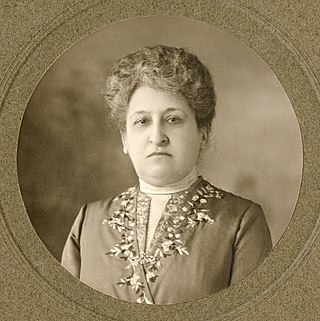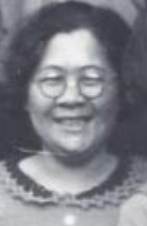
Aletta Henriëtte Jacobs was a Dutch physician and women's suffrage activist. As the first woman officially to attend a Dutch university, she became one of the first female physicians in the Netherlands. In 1882, she founded the world's first birth control clinic and was a leader in both the Dutch and international women's movements. She led campaigns aimed at deregulating prostitution, improving women's working conditions, promoting peace and calling for women's right to vote.

Geert Paul Hendrikus Schuitema was a Dutch graphic artist. He also designed furniture and expositions and worked as photographer, film director, painter and teacher for publicity design at the Royal Academy of Art in The Hague.
The Royal Netherlands Chemical Society is a learned society and professional association founded in 1903 to represent the interests of chemists and chemical engineers in the Netherlands. Currently the organisation has approximately 7,400 members.

Wilhelmina Drucker was a Dutch politician and writer. One of the first Dutch feminists, she was also known under her pseudonyms Gipsy, Gitano, and E. Prezcier.
Willem Berkhoff was a pastry chef who became the first chairman of the board of directors of the first Dutch Vocational School for Pastry Chefs, established in 1924 in Amsterdam and since 1956 named "De Berkhoff". Berkhoff became well known when he presented a traditional English wedding cake to Queen Wilhelmina (1880–1962) and Prince Henry (1876–1934) on the occasion of their marriage in 1901. Henceforth, the wedding cake became standard issue in Dutch wedding festivities. His "Pâtisserie and Refreshment Room" in the Leidsestraat was a household word in and outside Amsterdam, for over seventyfive years.

Agneta Wilhelmina Johanna van Marken-Matthes was a Dutch entrepreneur. She and her husband Jacques van Marken were involved in the manufacture of yeast throughout their lives, and were engaged in the co-operative movement, taking care of their workers. Matthes and Van Marken created living quarters for workers in her hometown, Delft in South Holland, named Agnetapark after her. These are considered a model for the co-operative development and construction of garden cities for workers. Matthes founded and ran a Delft perfume factory, Maison Neuve, to take advantage of a by-product from the yeast factory.

jkvr. Mariane Catherine van Hogendorp, a member of the Van Hogendorp family, was a Dutch feminist. She founded the Nederlandsche Vrouwenbond ter Verhooging van het Zedelijk Bewustzijn.

Jkvr. Jeltje de Bosch Kemper was a Dutch feminist.

Maria Wilhelmina Hendrika "Mietje" Hoitsema (1847–1934) was a Dutch feminist.
The Tesselschade-Arbeid Adelt (TAA) is a Dutch women's rights organization. Founded in 1871 under the name Algemeene Vrouwenvereeniging Arbeid Adelt, it was the first nationwide women's organisation in the Netherlands, and the eldest still operating. It split into the Arbeid Adelt (AA) and Tesselschade in 1872, but reunified into the Tesselschade-Arbeid Adelt in 1947.

Johanna Wilhelmina Antoinette Naber was a Dutch feminist, historian and author during the first feminist wave. She was one of the three founders of the International Archives for the Women's Movement (1935), now known as Atria Institute on gender equality and women's history, and was herself a prolific author of historical texts about influential women and the women's movement.

Johanna Gerarda Theodora van Eybergen was a Dutch artist specializing in applied arts and design, notable for her Art Nouveau work on metal. She was the first and for a long time the only Duch woman artist working on design on metal.

Mien van Wulfften Palthe was a Dutch feminist and pacifist. As a member of the Vereeniging voor Vrouwenkiesrecht and Women's International League for Peace and Freedom, she strove to secure enfranchisement for women and worked as an advocate peace.

Countess Anne Philippine Madeleine van Heerdt tot Eversberg-Quarles van Ufford was a Dutch feminist, artist, and peace activist. She was involved, among other things, as a board member of the Dutch Association for Women's Suffrage and as acting president of the World Union of Women for International Peace.

Betsy Thung Sin Nio was an Indonesian-Dutch women's rights activist, physician, economist and politician. Born into a wealthy and progressive Peranakan family of the 'Cabang Atas' gentry in Batavia, she was encouraged to obtain an education, which was unusual for Indonesian women at the time. After completing high school, she qualified as a bookkeeper, but – because social norms prevented women from doing office work – she became a teacher. After teaching briefly in an elementary school, in 1924 Thung enrolled at the Netherlands School of Business in Rotterdam to study economics. On graduating, she went on to earn a master's degree and a doctorate in economics. In 1932, she enrolled at the University of Amsterdam to pursue her medical studies.

Wilhelmina "Willie" Cornelia Drupsteen (1880–1966) was a Dutch illustrator. She is known for her graphic work and book illustrations.

The Nederlandsche Vereeniging voor Ambachts- en Nijverheidskunst (V.A.N.K.) was founded in 1904. It was founded by Jacob Pieter van den Bosch, Herman Hana, Klaas van Leeuwen, Theo Molkenboer, and Willem Penaat. At the turn of the century the idea of artist-craftsmen was emerging. The existing Dutch societies and clubs for painters and architects did not adequately represent these artisans and they formed V.A.N.K., the first society for designers in the Netherlands.

Johanna Berhardina Midderigh-Bokhorst (1880–1972) was a Dutch illustrator.

Nellie van Kol was a Dutch feminist, educator, and children's author also active in Belgium. She contributed to the cause of women and had a great influence on the development of children's literature in the 20th century.

















